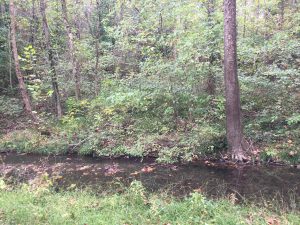The day was cool and breezy as I began my walk towards Carvin Creek under a colorless sky. When I came within view of my sit spot, I was immediately halted in my tracks by a saddening and unexpected sight. A doe was lying on her side in the water. She was swarming with flies and I could not see the rise and fall of her flank. What could have felled her? She didn’t have any visible wounds, so I thought it might be old age. As I averted my gaze, I noticed a turkey vulture was perched on the branch above her. His gaze was fixed on me, and as I got closer, he lifted his wings partly as if to fly away. Up close, the turkey vulture was an imposing figure, with a wing span of at least four feet. He didn’t settle down again until I walked away from him, which I felt was unexpected. Given their size, I wouldn’t have expected turkey vultures to be shy and skittish around humans.

Turkey vulture
I decided to temporarily find a new sit spot. The new sit spot I chose was within sight of my original sit spot, but still a good 20 feet away from it. I heard a loud cawing in the woods, which I presumed was a crow. A few times I watched their black shadows fly over me, before they disappeared behind the canopy. The constant chirp of crickets accompanied the light trickling of the creek. There were no visible invertebrates within sight of my sit spot, so I went to a spot along the creek with more activity.

My temporary sit spot
In this new spot, I noticed six water striders, an insect I had seen often in Carvin Creek but had never studied closely. As I leaned towards the water’s surface, I noticed their slim, brown bodies were raised above the water. As I watched them I began to feel curious about how the water striders managed to stay afloat and what they ate. After doing some research, I learned that the legs of the water strider are covered in thousands of microscopic hairs with tiny groves that trap air, which increases the buoyancy of the insect. The water strider preys on mosquito larvae, which breathe through a snorkel that extends above the surface. The water strider grabs the mosquito larvae by this snorkel and eats them. When food is scarce, water striders eat one another.
In my sit spot, water provides a habitat to freshwater organisms, most notably minnows and water striders. It also decomposes fallen leaves; soluble molecules from the leaves are leached into the water and microorganisms break the leaves down into inorganic molecules. The creek also offers a sanctuary to birds; I’ve seen sparrows bathing in the creek and a great blue heron standing motionless in the water, presumably to catch minnows. It provides a source of water to mammals, such as the deer who most likely came down the stream to drink. I noticed that some of the roots of the tree along the bank reached down into the water; this provides a significant benefit to the trees, which have access to a constant supply of water.
Now that my original sit spot holds such a saddening sight, I’m not entirely sure when I’ll be able to return to it. Will someone take it away or will it remain there, decomposing slowly? Despite this unexpected change, I maintained a steady concentration on my temporary sit spot. I didn’t have many assignments or obligations to address, so I was able to focus entirely on my surroundings with a relaxed state of mind. However, it was difficult to ignore the form of the deceased doe to my right, and my gaze kept getting drawn back to it. It gave me a new perspective on my sit spot, and I become hyper vigilant of the presence of death in this creek. After all, death occurred constantly in my sit spot; the doe made this apparent on a larger scale.


wow you got to see the deer from your spot! why did you move away from it? I didn’t think about turkey vultures being so big. Since they are so big I can see how they would be imposing figures. It seems like it was afraid of you because you are bigger than it is, but It could have been another reason.
So you have the same spot as Kia – and got to see the deer. I think the vulture you have pictured and most of the ones that were down there were black vultures. Neat info on the hairs on the legs of the water striders – who would think that hairs could keep you afloat!